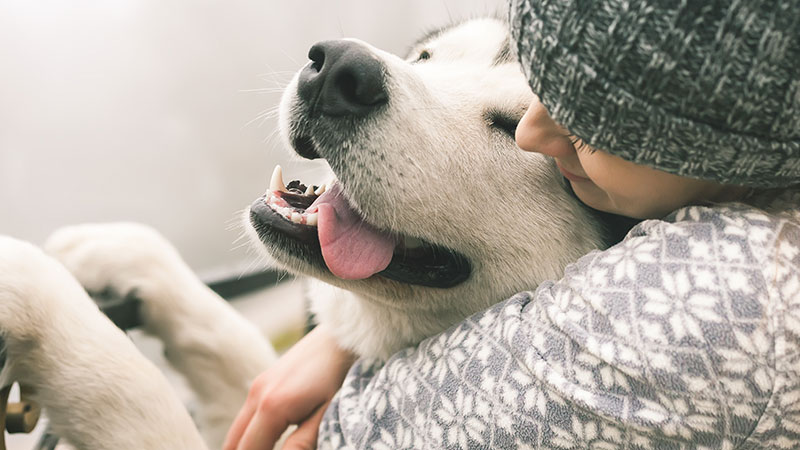No dog owner wants to learn that their pet has cancer, but more than 6 million will get that news this year. Fortunately, a cancer diagnosis is far from a death sentence. When pet owners and veterinarians catch the warning signs early, treatment is often quick, simple, and effective.
Dogs and cancer
The first thing to remember after a canine cancer diagnosis is that the disease is incredibly common. According to the University of Pennsylvania’s OncoLink team, it’s responsible for 47% of all dog deaths. That may not sound comforting, but the prevalence of diagnoses means that doctors have had a lot of experience treating cancer in all its forms.
Like humans, dogs become more susceptible to cancer as their immune systems weaken with age. A number of environmental and genetic factors can also lead to a cancer diagnosis. Veterinarians have identified more than a hundred types of canine cancer, including:
- Bladder cancer: As bladder cancer worsens, it can cause difficult urination or even a total blockage of the urinary tract.
- Breast cancer: Dr. Dave Ruslander, former President of the Veterinary Cancer Society, notes that this type of cancer is often easily preventable. By having female dogs spayed before their first heat, pet parents can “reduce the chance of mammary cancer eight-fold.”
- Hemangiosarcoma: This cancer develops in the blood vessels and tends to target the heart, liver, and spleen.
- Lymphoma: Common in both humans and dogs, this cancer affects the lymphatic system.
- Mast cell tumors: Most often, these tumors take the form of small nodules on your dog’s skin. They can affect other body parts, however, including the liver and intestines.
While mixed-breed dogs are less likely to contract a heritable form of cancer, they’re just as susceptible to the disease. Studies show that cancer rates are about equal among purebred and mixed-breed dogs.
What to ask your veterinarian
Addressing your pet’s cancer begins as soon as you’ve received the diagnosis. Start off on the right foot by consulting your veterinarian and getting all the information you’ll need:
- Realistically, what is my dog’s prognosis?
- What are my options for treatment? What do you recommend?
- Has the cancer spread throughout my dog’s body?
- Can I alleviate my dog’s pain and other symptoms?
- Should I consult any specialists?
- How should I update my pet care routine?
Treatment options for canine cancer
Veterinarians have developed a number of methods for fighting canine cancer. Depending on the type and severity of your dog’s disease, a veterinarian may recommend any of the following:
- Surgery: Many types of cancer can be completely removed through surgery alone. Dr. Ruslander even suggests that this is true for the majority of cases.
- Chemotherapy: The term “chemotherapy” is a broad one, referring to a range of potential drug treatments. Doctors may administer treatment orally, topically, or by injecting your dog.
- Radiation: Typically, radiation is used as a localized treatment for tumors that cannot be reached surgically.
Your veterinarian may combine approaches to combat particularly aggressive or widespread cancer.
Side effects of cancer treatment
Dogs tend to tolerate radiation and chemotherapy better than humans. At worst, their symptoms resemble much milder versions of the symptoms a human might experience. Your dog won’t lose their hair, but they may suffer mild nausea, diarrhea, and a loss of appetite. Keep in mind that these treatments can also potentially weaken your dog’s immune system and briefly leave them more susceptible to illness and infection. Consult your veterinarian if your dog exhibits a strong reaction to any form of treatment.
Paying for cancer treatment
Treating cancer can get pricey. Costs will vary based on your dog’s size, age, and breed, as well as the type and severity of cancer. Between the initial diagnosis, surgery, radiation, and/or chemotherapy, the veterinary bill can add-up quickly.
Every year, many pet parents are forced to make an impossible decision between their beloved pets and their family’s financial stability. While pet insurance can’t prevent dogs from getting sick, it can help ensure you never have to make such a heartbreaking choice. The accident and illness pet insurance plan includes cancer coverage, so you can focus on your pet’s health without worrying about the cost.
The road ahead
Even if your dog’s cancer is easily curable, that doesn’t mean the treatment and recovery process will be stress-free. Educate yourself on canine cancer and surround yourself with a support network. With information and affection on your side, you’ll make it through this difficult time.

